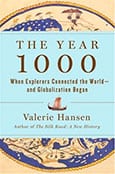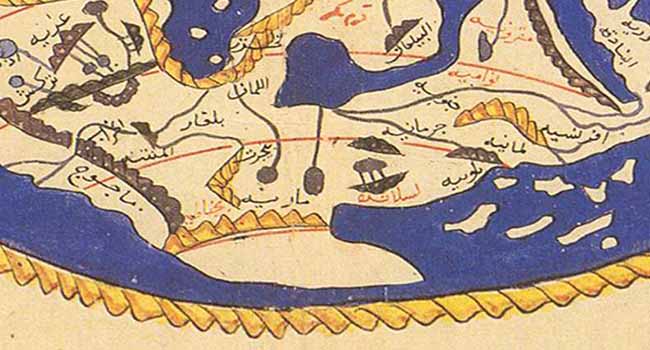 Valerie Hansen is an American academic who teaches history at Yale. She also writes books, of which 2012’s The Silk Road is perhaps the best known.
Valerie Hansen is an American academic who teaches history at Yale. She also writes books, of which 2012’s The Silk Road is perhaps the best known.
Hansen’s latest book is The Year 1000. Provocatively subtitled When Explorers Connected the World – and Globalization Began, it’s a recounting of interconnectedness in the five centuries between 1000 and 1500.
Hansen doesn’t seriously equate modern globalization with the world she describes in her book. But she’s anxious to demonstrate that the concept of international trading networks and linkages goes back a very long way. So recognizing Leif Erikson’s voyages as Europe’s first tentative connection with the Americas, 1000 is chosen as the fulcrum for her narrative.
Hansen sets the stage by painting a picture of the world as it existed then. Or expressed more realistically, she provides history’s current best guess.
In 1000, Asia accounted for over 50 per cent of the world’s population, with China being easily the largest component. Europe and Africa came next. Roughly equal in size, they had as much as 40 per cent of the total population between them. This left the remainder for the Americas (Oceania’s numbers weren’t significant).
China was also the world’s most extensive trader. High-end ceramics and other manufactures were exported to the Middle East, India, Southeast Asia and even Africa. In return, China imported jewelry, display objects, spices and raw material for aromatics.
Hansen’s book is simultaneously accessible and dense. Notwithstanding the easy prose, the level of detail sometimes blurs as she traverses between continents and centuries.
Still, there’s a lot of worthwhile information. Even well-informed readers will probably find some things they didn’t know or had forgotten.
Here are several that struck me:
Ocean currents
Knowledge of specific currents was an important part of successful navigation.
 Called gyres, large rotating ocean currents are a function of “wind patterns, gravity, heat from the sun, and the speed of the earth’s rotation. The gyres in the Northern Hemisphere – the North Atlantic Gyre and the North Pacific Gyre – flow clockwise, while those in the Southern Hemisphere go counterclockwise.”
Called gyres, large rotating ocean currents are a function of “wind patterns, gravity, heat from the sun, and the speed of the earth’s rotation. The gyres in the Northern Hemisphere – the North Atlantic Gyre and the North Pacific Gyre – flow clockwise, while those in the Southern Hemisphere go counterclockwise.”
All told, there are five major gyres and sailors who understood them could tailor their voyages accordingly.
For instance, Hansen describes sailing on the Gulf Stream – part of the North Atlantic Gyre – as equivalent to “taking a fast-moving river through a sluggish ocean.” And as the Gulf Stream is about 70 km wide and a different colour from the surrounding water, those savvy enough to know what they were looking for benefited from a current moving at around 160 km a day.
Slavery
Although we’re accustomed to focusing on the notorious Atlantic slave trade, most of us probably know that slavery was a pervasive practice dating back to antiquity. To quote Hansen, “For much of human history, slavery was a big business.”
Constantinople and Baghdad were two major markets, the latter serving as the primary entry point for distribution through the Islamic world. Slaves were sourced from Eastern Europe and Africa, having been sold on to slave traders by native rulers and merchants.
They don’t build borders like they used to by Constantine Passaris
Providing a sense of scale, Hansen notes that the number of Africans sold to the Islamic world between 800 and 1800 rivalled the numbers shipped to the Americas.
There was even a slave buyers manual written by one Ibn Butlan. Among its pointers was the advice that female slaves from what’s now Ethiopia and Sudan were best purchased young, before they’d been subjected to genital mutilation.
Trade networks
There’s an interesting chapter titled The Pan-American Highways of 1000, the bottom line of which is that post-Columbus Europeans didn’t invent American trade networks. Instead, they built on a pre-existing network and connected it to Europe.
The Americas’ largest city in 1000 was probably the Mayan capital of Chichen Itza in Mexico’s Yucatan Peninsula. With a population estimated at 40,000, Chichen Itza had trading relationships extending as far north as New Mexico and Illinois and as far south as Colombia. Turquoise, chocolate and tropical birds were among the cherished items of exchange.
Comparative technology
Whereas people who encountered each other in the year 1000 were relatively close technologically, firearms and cannon gave Europeans a major advantage after 1500.
Then the 19th century Industrial Revolution dramatically compounded that edge. Thanks to steamships, railroads and the telegraph, European powers could move troops and people in a hitherto unimaginable way.
The balance of power had been dramatically altered.
Troy Media columnist Pat Murphy casts a history buff’s eye at the goings-on in our world. Never cynical – well perhaps a little bit.
The views, opinions and positions expressed by columnists and contributors are the author’s alone. They do not inherently or expressly reflect the views, opinions and/or positions of our publication.


